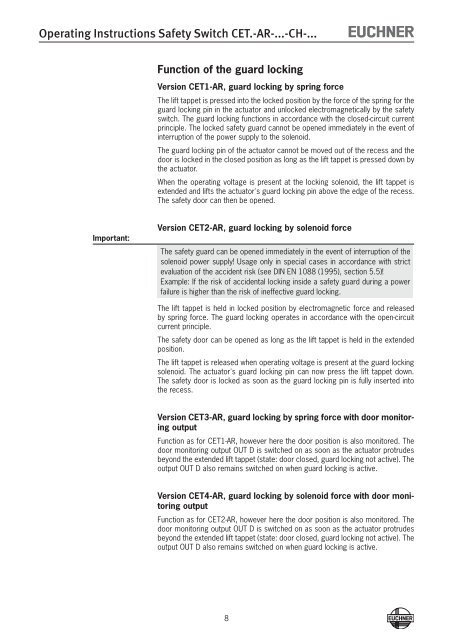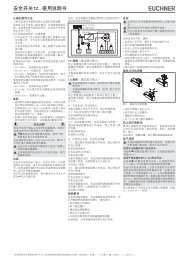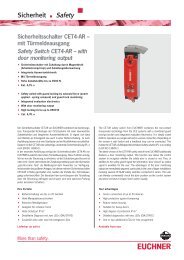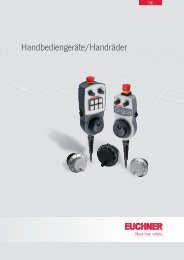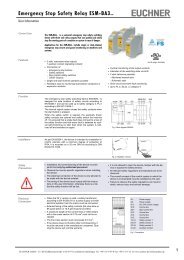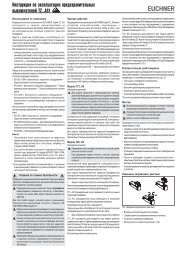Operating Instructions Non-Contact Safety Switch CET.-AR-...-CH ...
Operating Instructions Non-Contact Safety Switch CET.-AR-...-CH ...
Operating Instructions Non-Contact Safety Switch CET.-AR-...-CH ...
You also want an ePaper? Increase the reach of your titles
YUMPU automatically turns print PDFs into web optimized ePapers that Google loves.
<strong>Operating</strong> <strong>Instructions</strong> <strong>Safety</strong> <strong>Switch</strong> <strong>CET</strong>.-<strong>AR</strong>-...-<strong>CH</strong>-...<br />
Function of the guard locking<br />
Version <strong>CET</strong>1-<strong>AR</strong>, guard locking by spring force<br />
The lift tappet is pressed into the locked position by the force of the spring for the<br />
guard locking pin in the actuator and unlocked electromagnetically by the safety<br />
switch. The guard locking functions in accordance with the closed-circuit current<br />
principle. The locked safety guard cannot be opened immediately in the event of<br />
interruption of the power supply to the solenoid.<br />
The guard locking pin of the actuator cannot be moved out of the recess and the<br />
door is locked in the closed position as long as the lift tappet is pressed down by<br />
the actuator.<br />
When the operating voltage is present at the locking solenoid, the lift tappet is<br />
extended and lifts the actuator's guard locking pin above the edge of the recess.<br />
The safety door can then be opened.<br />
Important:<br />
Version <strong>CET</strong>2-<strong>AR</strong>, guard locking by solenoid force<br />
The safety guard can be opened immediately in the event of interruption of the<br />
solenoid power supply! Usage only in special cases in accordance with strict<br />
evaluation of the accident risk (see DIN EN 1088 (1995), section 5.5)!<br />
Example: If the risk of accidental locking inside a safety guard during a power<br />
failure is higher than the risk of ineffective guard locking.<br />
The lift tappet is held in locked position by electromagnetic force and released<br />
by spring force. The guard locking operates in accordance with the open-circuit<br />
current principle.<br />
The safety door can be opened as long as the lift tappet is held in the extended<br />
position.<br />
The lift tappet is released when operating voltage is present at the guard locking<br />
solenoid. The actuator's guard locking pin can now press the lift tappet down.<br />
The safety door is locked as soon as the guard locking pin is fully inserted into<br />
the recess.<br />
Version <strong>CET</strong>3-<strong>AR</strong>, guard locking by spring force with door monitoring<br />
output<br />
Function as for <strong>CET</strong>1-<strong>AR</strong>, however here the door position is also monitored. The<br />
door monitoring output OUT D is switched on as soon as the actuator protrudes<br />
beyond the extended lift tappet (state: door closed, guard locking not active). The<br />
output OUT D also remains switched on when guard locking is active.<br />
Version <strong>CET</strong>4-<strong>AR</strong>, guard locking by solenoid force with door monitoring<br />
output<br />
Function as for <strong>CET</strong>2-<strong>AR</strong>, however here the door position is also monitored. The<br />
door monitoring output OUT D is switched on as soon as the actuator protrudes<br />
beyond the extended lift tappet (state: door closed, guard locking not active). The<br />
output OUT D also remains switched on when guard locking is active.<br />
8


